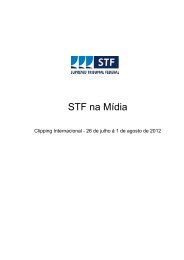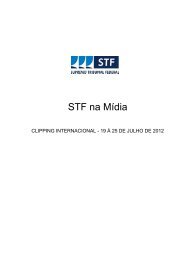STF na MÃdia - MyClipp
STF na MÃdia - MyClipp
STF na MÃdia - MyClipp
Create successful ePaper yourself
Turn your PDF publications into a flip-book with our unique Google optimized e-Paper software.
quickly began to climb, driven by California’s fast-rising<br />
Latino population. By 2010, that group accounted for<br />
more than 22 percent of the system’s freshmen.<br />
“If we had affirmative action as one of our tools, we’d<br />
do somewhat better for Hispanics, and we’d probably<br />
do significantly better for African-Americans,” said<br />
Mark G. Yudof, president of the University of California<br />
system.<br />
A central part of California’s effort has been to<br />
compare applicants with other students in their<br />
communities, rather than with students statewide,<br />
much as Texas does. At each high school, the top 9<br />
percent of students are guaranteed admission to the<br />
University of California — though not necessarily to the<br />
campuses of their choice — as long as they meet<br />
some other criteria.<br />
Officials acknowledge that the aim is race-conscious<br />
but that the mechanism is race-neutral.<br />
Florida uses a percentage-based system as well.<br />
There, as in California and Texas, the benefits go<br />
mostly to Hispanic students because of the large<br />
number of high schools that are predomi<strong>na</strong>ntly<br />
Hispanic. Black students are spread among high<br />
schools with large numbers of other students.<br />
In California, arguably the most liberal state to have<br />
banned affirmative action in admissions, the university<br />
system has gone further to increase minority<br />
enrollment. The system has expanded, adding a new<br />
campus and increasing enrollment at existing schools.<br />
The Berkeley campus, and later U.C.L.A., also<br />
adopted an admissions approach called holistic<br />
review, reducing the emphasis on grades and test<br />
scores while taking a broader look at students’<br />
experiences and the challenges they have overcome.<br />
The New York Times/ - Politics, Seg, 02 de Abril de 2012<br />
CLIPPING INTERNACIONAL (Supreme Court)<br />
“I do think you’re going to see a move toward a more<br />
holistic admissions system” in other states, Mr. Yudof<br />
said, especially if the Supreme Court rolls back<br />
consideration of race. His system is pushing all of its<br />
campuses in that direction.<br />
Some of the public universities in Washington State,<br />
where voters banned affirmative action in 1998, use a<br />
holistic approach, as does the University of Michigan.<br />
Richard H. Sander, a U.C.L.A. law school professor<br />
who studies the issue, says that the holistic approach<br />
is also loose enough to allow race to be an<br />
u<strong>na</strong>cknowledged part of the equation, potentially<br />
violating state law. University officials insist that their<br />
systems are race-blind.<br />
In Washington, Hispanic and black enrollment at state<br />
universities did not change much after the law went<br />
into effect, but at the state’s flagship, the University of<br />
Washington, it fell for a few years, before returning to<br />
its former level. At the University of Michigan, minority<br />
enrollment fell sharply after the law took effect in 2007,<br />
and has not rebounded. Black students made up more<br />
than 10 percent of the freshman class a decade ago,<br />
and 7 to 8 percent in the years just before the law, but<br />
that has dropped to a little over 5 percent in recent<br />
years.<br />
As for the Fisher case, Professor Sander pointed to<br />
the crucial role of Justice Anthony M. Kennedy, widely<br />
seen as the swing vote. He predicted that rather than<br />
overturn the standards it set in 2003, the court would<br />
amend them or alter the way they are carried out,<br />
restricting the use of race without elimi<strong>na</strong>ting it. “This<br />
hinges on Kennedy,” Professor Sander said, “and<br />
Kennedy usually likes to do half a loaf.”<br />
198











